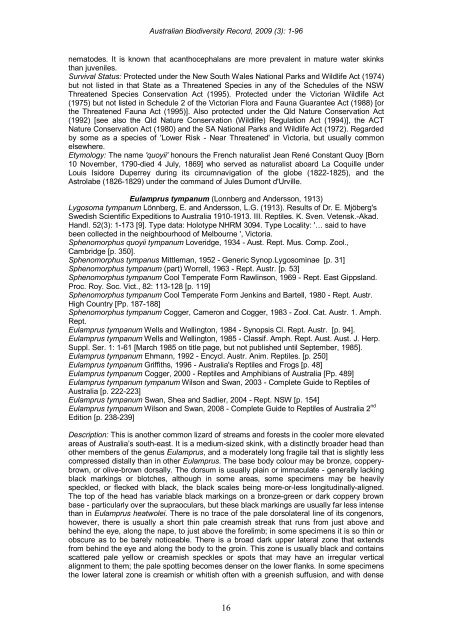AUSTRALIAN BIODIVERSITY RECORD - Calodema
AUSTRALIAN BIODIVERSITY RECORD - Calodema
AUSTRALIAN BIODIVERSITY RECORD - Calodema
Create successful ePaper yourself
Turn your PDF publications into a flip-book with our unique Google optimized e-Paper software.
Australian Biodiversity Record, 2009 (3): 1-96<br />
nematodes. It is known that acanthocephalans are more prevalent in mature water skinks<br />
than juveniles.<br />
Survival Status: Protected under the New South Wales National Parks and Wildlife Act (1974)<br />
but not listed in that State as a Threatened Species in any of the Schedules of the NSW<br />
Threatened Species Conservation Act (1995). Protected under the Victorian Wildlife Act<br />
(1975) but not listed in Schedule 2 of the Victorian Flora and Fauna Guarantee Act (1988) [or<br />
the Threatened Fauna Act (1995)]. Also protected under the Qld Nature Conservation Act<br />
(1992) [see also the Qld Nature Conservation (Wildlife) Regulation Act (1994)], the ACT<br />
Nature Conservation Act (1980) and the SA National Parks and Wildlife Act (1972). Regarded<br />
by some as a species of 'Lower Risk - Near Threatened' in Victoria, but usually common<br />
elsewhere.<br />
Etymology: The name 'quoyii' honours the French naturalist Jean René Constant Quoy [Born<br />
10 November, 1790-died 4 July, 1869] who served as naturalist aboard La Coquille under<br />
Louis Isidore Duperrey during its circumnavigation of the globe (1822-1825), and the<br />
Astrolabe (1826-1829) under the command of Jules Dumont d'Urville.<br />
Eulamprus tympanum (Lonnberg and Andersson, 1913)<br />
Lygosoma tympanum Lönnberg, E. and Andersson, L.G. (1913). Results of Dr. E. Mjöberg's<br />
Swedish Scientific Expeditions to Australia 1910-1913. III. Reptiles. K. Sven. Vetensk.-Akad.<br />
Handl. 52(3): 1-173 [9]. Type data: Holotype NHRM 3094. Type Locality: '… said to have<br />
been collected in the neighbourhood of Melbourne ', Victoria.<br />
Sphenomorphus quoyii tympanum Loveridge, 1934 - Aust. Rept. Mus. Comp. Zool.,<br />
Cambridge [p. 350].<br />
Sphenomorphus tympanus Mittleman, 1952 - Generic Synop.Lygosominae [p. 31]<br />
Sphenomorphus tympanum (part) Worrell, 1963 - Rept. Austr. [p. 53]<br />
Sphenomorphus tympanum Cool Temperate Form Rawlinson, 1969 - Rept. East Gippsland.<br />
Proc. Roy. Soc. Vict., 82: 113-128 [p. 119]<br />
Sphenomorphus tympanum Cool Temperate Form Jenkins and Bartell, 1980 - Rept. Austr.<br />
High Country [Pp. 187-188]<br />
Sphenomorphus tympanum Cogger, Cameron and Cogger, 1983 - Zool. Cat. Austr. 1. Amph.<br />
Rept.<br />
Eulamprus tympanum Wells and Wellington, 1984 - Synopsis Cl. Rept. Austr. [p. 94].<br />
Eulamprus tympanum Wells and Wellington, 1985 - Classif. Amph. Rept. Aust. Aust. J. Herp.<br />
Suppl. Ser. 1: 1-61 [March 1985 on title page, but not published until September, 1985].<br />
Eulamprus tympanum Ehmann, 1992 - Encycl. Austr. Anim. Reptiles. [p. 250]<br />
Eulamprus tympanum Griffiths, 1996 - Australia's Reptiles and Frogs [p. 48]<br />
Eulamprus tympanum Cogger, 2000 - Reptiles and Amphibians of Australia [Pp. 489]<br />
Eulamprus tympanum tympanum Wilson and Swan, 2003 - Complete Guide to Reptiles of<br />
Australia [p. 222-223]<br />
Eulamprus tympanum Swan, Shea and Sadlier, 2004 - Rept. NSW [p. 154]<br />
Eulamprus tympanum Wilson and Swan, 2008 - Complete Guide to Reptiles of Australia 2 nd<br />
Edition [p. 238-239]<br />
Description: This is another common lizard of streams and forests in the cooler more elevated<br />
areas of Australia’s south-east. It is a medium-sized skink, with a distinctly broader head than<br />
other members of the genus Eulamprus, and a moderately long fragile tail that is slightly less<br />
compressed distally than in other Eulamprus. The base body colour may be bronze, copperybrown,<br />
or olive-brown dorsally. The dorsum is usually plain or immaculate - generally lacking<br />
black markings or blotches, although in some areas, some specimens may be heavily<br />
speckled, or flecked with black, the black scales being more-or-less longitudinally-aligned.<br />
The top of the head has variable black markings on a bronze-green or dark coppery brown<br />
base - particularly over the supraoculars, but these black markings are usually far less intense<br />
than in Eulamprus heatwolei. There is no trace of the pale dorsolateral line of its congenors,<br />
however, there is usually a short thin pale creamish streak that runs from just above and<br />
behind the eye, along the nape, to just above the forelimb; in some specimens it is so thin or<br />
obscure as to be barely noticeable. There is a broad dark upper lateral zone that extends<br />
from behind the eye and along the body to the groin. This zone is usually black and contains<br />
scattered pale yellow or creamish speckles or spots that may have an irregular vertical<br />
alignment to them; the pale spotting becomes denser on the lower flanks. In some specimens<br />
the lower lateral zone is creamish or whitish often with a greenish suffusion, and with dense<br />
16

















